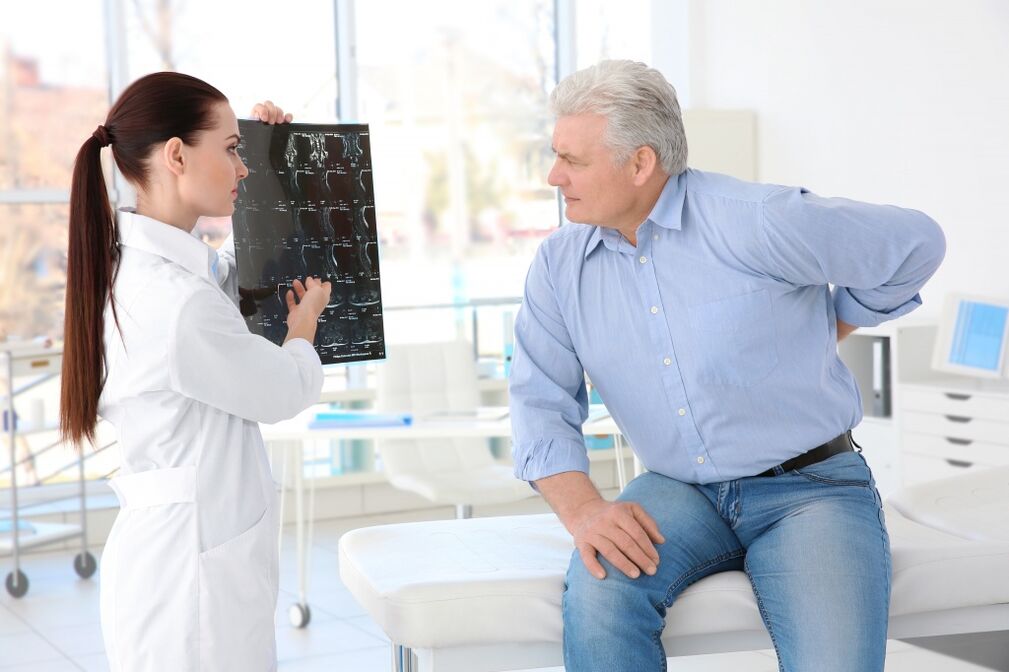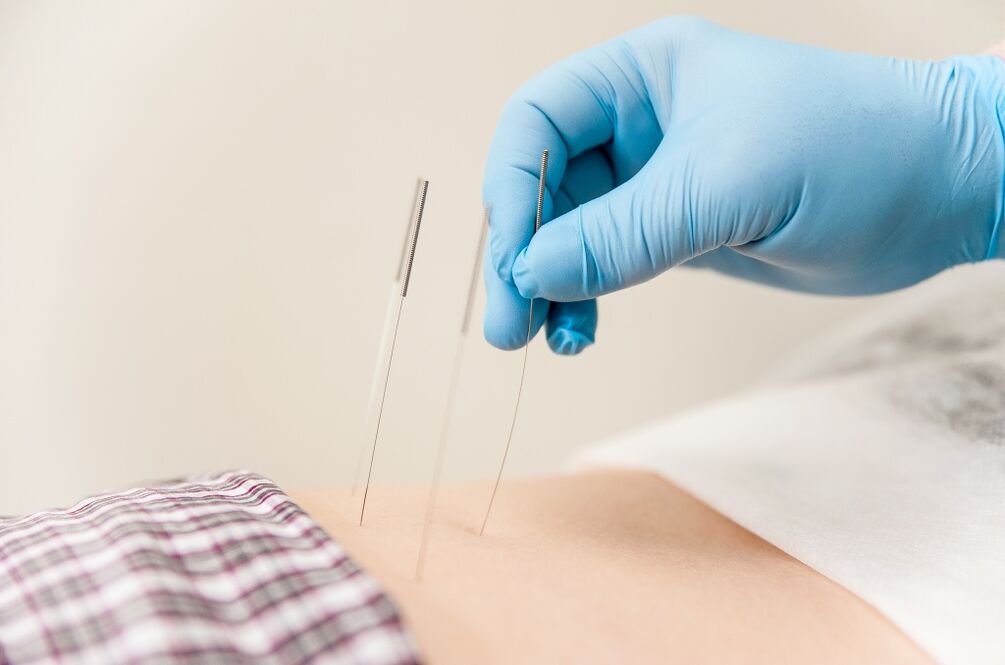Osteochondrosis is called a dissophytic-deep cartilage tissue disease of the intervertebral joints, which leads to their destruction.The localization of osteochondrosis in the vertebrae of the thain is called thoracic osteochondrosis.Compared to the osteochondrosis of another localization - cervical or lumbar osteochondrosis is diagnosed more rarely by the anatomical characteristics of the breast structure.This is a relatively static structure in which the mobility of the spine itself is relatively small - respectively, even in the active pathological process in the intervertebral discs, the likelihood of their injury is minimal.In the recent past, when diagnostic capabilities were limited, thoracic osteochondrosis was considered the prerogative of extremely elderly patients.Now it is identified not only in young but even in childhood.

Why does breast osteochondrosis develop?
Among the causes of thoracic osteochondrosis, the following should be distinguished:
- Pathology of the vertebrae and intervertebral discs - both hereditary and acquired as a result of various factors;
- disorders of the blood supply to the spine;
- Excessive or irrational physical activity of the spine (when you exercise or due to heavy physical work);
- disorders of mineral metabolism in the body, deficiency of some trace elements;
- sedentary lifestyle, stuck professional activity;
- weakness of the posterior muscles, resulting in improper posture and irrational distribution of spinal load;
- Injuries.
In addition, there are a number of factors that can cause exacerbation of the disease in its chronic course:
- Injury;
- stress, excessive nervous tension;
- Body hypothermia - both general and local hypothermia of the back muscles;
- Physical fatigue.
Why is thoracic osteochondrosis dangerous?
Chest osteochondrosis is a disease accompanied by significant pathological changes in the vertebrae and intervertebral joints.Accordingly, the first consequence of such a disease is the destruction of structures that form the spine.The result of this may be scoliosis, pathology of the respiratory system (pneumonia, pneumosclerosis), impaired blood circulation of internal organs, diseases of the upper gastrointestinal tract (pancreatitis, cholecystitis).The negative effects of thoracic osteochondrosis can also be applied to the lesson system.Permanent pain syndrome characteristic of osteochondrosis reduces the quality of life and can "conceal" for other diseases, which causes improper diagnoses and treatment.
How is breast osteochondrosis manifesting?
With thoracic osteochondrosis, symptoms are quite characteristic:
- pain - It occurs when a person is in one position for a long time, as well as with movements, lifting weights, physical exertion.Dumb constant pain in the area of shoulder blades is characteristic, as is the pain when trying to lift your hands;
- Mecostal neuralgia;
- Sensation in the chest, as a result of which deep breathing becomes difficult;
- Reduction of sensitivity certain areas of the skin;
- Paresthesia - feeling of "creeping geese" on the skin, burning, numbness;
- Temperature reduction certain areas of the skin;
- Temperature reduction To skin, Itchy burning in them;
- Digestive disorders.
Dorsalgius (prolonged pain in the affected intervertebral) and dorsago (intense pain) distinguishes two main types of pain accompanying osteochondrosis of the thoracic spine: Dorsalgiyu (prolonged pain in the area of the affected cartilage) and intense pain in the area of the area.
SO -the adherent SO -administered osteochondrosis is characteristic of osteochondrosis Gastro Syndrome - Epigastric pain that is not related to nutrition, time of day or year.
Thoracic osteochondrosis
In clinical practice, 4 degrees of osteochondrosis of the thain is distinguished, depending on the degree of damage to the cartilage and the participation in the pathological process of the surrounding structures.
First -degree thain osteochondrosis of the spinal cord: The discs between the vertebrae lose their elasticity, somewhat thin, local protrusions - bulge can appear in the fibrous rings of the discs.
Thoracic osteochondrosis of Grade 2: The thinning of the intervertebral discs progresses, the chest spine loses stability.At this stage, the pain begins to worry, often neurological symptoms join her: paresthesia, numbness of the skin.Cracks may appear on the fibrous ring of the intervertebral disc.
Thoracic osteochondrosis of the spine of 3 degrees It corresponds to the formation of intervertebral hernia.
Thoracic osteochondrosis 4 degrees It is characterized by a complete loss between the spinal disc of its depreciation properties.Leaving the vertebrae becomes critical, bone tissue begins to collapse.In the channels of the spine, blood vessels and nerves are impaired, leading to persistent neurological symptoms, intense syndrome of pain, blood circulation.
Diagnosis of breast osteochondrosis
The diagnosis of "thoracic osteochondrosis" is made on the basis of a patient examination, examination and examination: radiography and magnetic resonance.X -ray study helps to determine the location of the spine lesion, and magnetic resonance is to clarify the diagnosis to exclude the presence of benign and malignant neoplasms.
A number of symptoms of osteochondrosis of the chest spine are nonspecific - the same signs may indicate other diseases.This explains quite frequent errors in the diagnosis when the patient, for example, has been treated for a long time for pancreatitis due to pain, the true cause of which is osteochondrosis of the breast.Therefore, overall diagnostics, attraction of neighboring specialists - gastroenterologists, pulmonologists - are very important for further examination of the patient.
Thoracic osteochondrosis: Treatment

Given the fact that the restoration of destroyed cartilage is impossible, the effective treatment of breast osteochondrosis is only possible in the initial stages of the disease, while cartilage has not yet lost its structure.Therefore, it is especially important to consult a doctor in a timely manner - when the first manifestations of pathology, discomfort in the back, have slight pain, numbness of the skin areas or its burning sensation.
In the first stages of the disease, treatment is reduced to the administration of non -corpse analgesics, which allows pain and non -steroidal anti -inflammatory drugs that reduce the intensity of the inflammatory process in the tissues and also eliminate the pain.The main focus in the treatment of the initial stage of osteochondrosis of the chest spine is made to obtain a chondroprotector.This is the name of a group of medicines designed to restore normal metabolism in cartilage tissue, leading to improvement of cartilage trophism and delaying its destruction.
With the progression of the pathological process of non -steroidal anti -inflammatory agents to relieve inflammation, as a rule, this is not enough, which forces the doctor to supplement the glucose of cortico with steroid drugs.In addition, diuretics can be added to the list of drugs that allow elimination of swelling in the roots of the disturbed spinal nerves and thus relieve the appropriate neurological symptoms and pain.The inclusion of antispasmodic drugs in therapy allows to eliminate muscle spasm, which accompanies osteochondrosis of the thoracic spine.
With the development of intervertebral hernia and the destruction of bone tissue of the vertebrae, conservative treatment loses its effectiveness, the only reasonable alternative is the surgical treatment of osteochondrosis.
Physiotherapy for breast osteochondrosis
Outside the periods of exacerbation, physiotherapy brings good results.The methods effective in osteochondrosis of the chest region include:
- laser therapy;
- magnetotherapy;
- Lengthening - both dry and wet;
- vacuum therapy;
- acupuncture;
- Farmakopunktura.
In addition, massage and manual therapy include popular and effective physiotherapy methods for breast osteochondrosis.Preventive massage courses for patients with osteochondrosis of the thoracic region should undergo at least twice a year.At the same time, all manipulations must be as much as possible, exclusively outside the periods of exacerbation, in order not to cause exacerbation of the pathological process.

Media physical education for thoracic osteochondrosis
An important component of the complex treatment of thoracic osteochondrosis of the spine is therapeutic physical education (exercise therapy). The task of exercise is to restore the mobility of the intervertebral joints, to eliminate muscle spasm, to eliminate stiffness in the spine.LFK allows you to strengthen the muscle corset as well as to increase the patient's physical mobility as a whole, which is an important factor in stimulating blood circulation, restoring lung ventilation.
Before performing a complex of special exercises, you need to perform a lightweight warm -up, aimed at warming your muscles or take a warm shower.High quality heating before classes avoid injuries.All movements should be smooth, it is necessary to avoid sharp inclinations and turns that can worsen the damage of the spine.
Chest osteochondrosis is a chronic disease that significantly reduces the quality of life of the patient, dangerous from his complications.Timely address to the doctor and the competent complex treatment, started with the first signs of the disease, will help to stop the pathological process and eliminate the unpleasant symptoms.



































